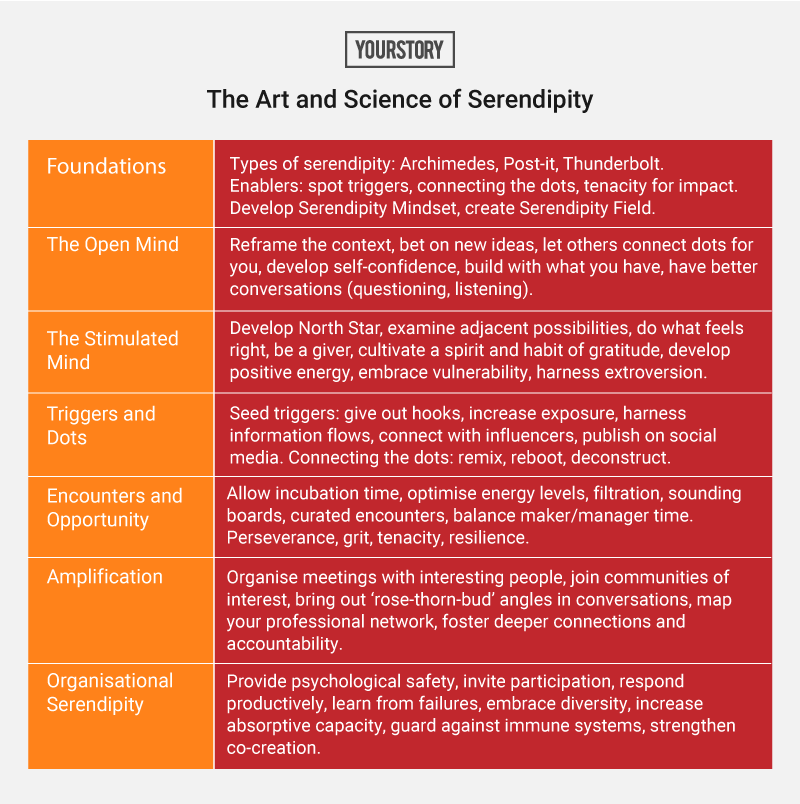Launched in 2012, YourStory's Book Review section features over 275 titles on creativity, innovation, knowledge work, and digital transformation. See also our related columns The Turning Point, Techie Tuesdays, and Storybites.
Frameworks and actions to enable coincidences to arise and take advantage of them are well explained in the new book by Christian Busch, The Serendipity Mindset: The Art and Science of Creating Good Luck.
Success comes not just from talent and hard work, but also luck. And, we can make luck favour us by taking conscious steps to cultivate the serendipity mindset and “serendipity field.”
Luck can be about more than randomness – it can be about enabling fortunate connections to happen and systematically harnessing them. Individuals and organisations can foster the conditions to let serendipity grow in their personal and professional lives, the author argues.
The ten chapters in the book are thoroughly referenced, with 24 pages of notes and 24 pages of sources. The author cites examples from startups and scientists, biology and chemistry. We can all “grasp, shape, and hone” serendipity, as shown in the dozens of stories in the book.
Today’s global, always-connected, and fast-changing digital world opens up even more scope and opportunity for serendipity, allowing for more dots to be connected in new pathways. Success comes from an open and experimental mindset and not just from a focus on efficiency, plans, and control.
Christian Busch is the Director of the Global Economy Programme at New York University’s Centre for Global Affairs, and also teaches at the London School of Economics. He is the Co-founder of Leaders on Purpose and the Sandbox Network and divides his time between New York and London. Born and raised in Germany, he also co-directed the LSE's Innovation and Co-Creation Lab.
Here are my key clusters of takeaways from this 375-page book, summarised as well in the table below. See also my reviews of the related books, The Creative Mindset, The Art of Noticing, The Creative Curve, Quirky, The Unfair Advantage, Rebel Talent, When, and The Startup Community Way.
The book makes for a fascinating and useful read, though some times the material comes across as repetitive. Each chapter ends with tips for serendipity, and the book ends with a 38-question checklist to assess one’s serendipity – these could be presented more systematically, and would be good to expand in an online companion for this book.

Serendipity in action
The book cites numerous examples of serendipitous moments and journeys in action in small moments, as well as life-changing events.
“Inventions such as nylon, Velcro, Viagra, Post-it Notes, X-rays, penicillin, rubber, and microwave ovens all involved serendipity,” Christian shows. Combinatorial chemistry is based on intentionally creating thousands of accidental combinations of compounds and spotting uses for them.
Professor Aaron Kellner noticed an unusual reaction in rabbits to an enzyme reaction – unlike others who also observed it — he held on to it and followed up to eventually make a breakthrough in understanding arthritis. He won a Nobel Prize for the discovery.
In the business world, successful companies leverage “serendipity spotters.” Haier creates new products by intentionally putting creative employees face to face with customers for unexpected suggestions, such as designing machines for farmers to wash muddy potatoes.
Pixar’s campus, with a central atrium and café, is designed to promote “inadvertent encounters” between artists, designers, and techies. The Web Summit conference and exhibition uses a data-driven approach via graph theory to map out physical and virtual opportunities for attendee matchmaking.
Other organisations promote random creative connections over lunch and drinks, such as Lunch Lottery, HubSpot (“learning lunches” with outsiders), LinkedIn (subsidised lunches), NESTA (“randomised coffee trial”), and Wok+Wine.
Bernard Sadow invented the rolling suitcase in the 1970s when he had trouble dragging his heavy suitcases at an airport – and saw a worker using a wheeled skid to move a heavy machine.
Payment services in Kenya were improved not by traditional approaches of ATM networks and bank branches, but by leveraging what was more readily available: mobile networks (MPesa).
Social entrepreneurs are particularly adept at leveraging serendipity. South Africa’s Reconstructed Living Labs (RTLabs) leverages people’s talent and assets in existing networks in a bottom-up manner, rather than depending on Western aid.
Sharing stories of hope can play a powerful inspiring role, the author observes. RTLabs members create their own luck by focussing on co-creation activity and opportunity; they frame as resources what they have and who they know.
The first job which Canadian filmmaker Geneva Peschka took when she moved to New York City was to look after an autistic child. She made a film on the life of the child, which went on to become the award-winning documentary Unspoken.
Activist Bibi La Luz Gonzalez attended a premiere of a movie about human trafficking in South Asia. It so moved her that she tracked down the director for an interview, and eventually launched a campaign against trafficking in Central America.
A conversation with a UN officer in a lift brought to life doctor Amina Aitsi-Selmi’s dream of working for global health projects. She eventually ended up working on sustainability and health issues as a development consultant.
Rapper Aadarsh Gautam uploaded a video on Instagram which was liked by a radio presenter; he followed up and was eventually featured on BBC radio. Hairstylist Phil McRory got the idea for using oil spill mats based on discarded human hair while sweeping his barber’s shop and watching the news about the Exxon oil spill.
Howard Schultz got the idea for Starbucks after seeing coffee bar culture in Italy. He developed a whole model of value creation after numerous experiments and iterations.
The idea for Sofar Sounds music gigs at home came about when the founders were annoyed by the noise from other concertgoers during a public concert. Ojos Que Sienten — founded by Mexican social entrepreneur Gina Badenoch — offers “dining in the dark” experiences for people to have different conversations and discoveries.
Stranded in London with many conference attendees due to an air travel disruption, entrepreneur Nathaniel Whittemore nimbly organised the first-ever TEDxVolcano conference in 2010.
The author’s own near-death experience as a teenager in a rash car-driving accident led him down the path of searching for meaning and impact. He met one of his girlfriends as well through a café encounter.
Foundations
The author distinguishes between “blind luck” (pure chance) and “smart luck” or “active luck” (enabled by our own actions). A “serendipitor” is defined as someone who cultivates serendipity. “Compounded serendipity” is the cascading potential of new instances of serendipity.
An important skill to be taught is the ability to navigate the unexpected and make our own smart luck, Christian emphasises. Serendipity is about enabling dots to emerge, connecting them, and acting on them; it turns unexpected discoveries into outcomes with value.
“Openness to the unexpected is key being lucky,” the author explains. Having a broader field of vision keeps one attuned to unexpectedly useful things. Spotting triggers should be followed up by creative recombinations, which can involve tenacious efforts, as well as inputs from other collaborators.
Unblocking pathways to serendipity requires one to avoid conformity, acknowledge emergence, and break the trap of functional fixedness. Unfortunately, herd mentality and sticking to consensus can get in the way. A tendency to want control even leads to downplaying the role of the unexpected while explaining past actions, the author cautions.
Business leaders want to come across as being in control and not admitting to unexpected variances. The “official story” is presented as a linear story, without the zigzags and emergence that should truly be acknowledged. Core competencies should not become “core rigidities,” the author warns.
Having described these foundations, the author describes six steps towards serendipity mindsets and skillsets as reviewed in the sections below.

1. The Open Mind
“Curious, open, and questioning minds are at the core of making discoveries and creating serendipity,” the author explains. Examples of cross-disciplinary innovators are Leonardo da Vinci, Albert Einstein, and Steve Jobs.
Reframing helps see luck not just as a chance, but as a cultivable opportunity to see bridges where others see gaps. This is the first nudge towards serendipity, the author explains. People who see themselves as lucky compare themselves with others who are unlucky, whereas people who lament that they are not fortunate, compare themselves with those who are lucky, the author observes.
Having a “strong, yet malleable North Star” is important — it helps to have a sense of direction and also be open to variations in pathways and make adjustments and iterations to existing models. Serendipity is more important at the early stages of projects, while focus and concentration are needed later.
In conversations, serendipity triggers can include questions like What are you inspired by right now, What does success mean to you, or What experiences shaped you? A focus on motivations and challenges is better than mere facts.
Businesses should focus on not just cost-cutting but on higher-margin products; drilling down to root causes helps understand operational issues better. Addressing customer aspirations and not just immediate problems can unlock new opportunity. Approaches like design thinking help iterative problem formulation before defining problems too narrowly, the author shows.
Ambiguity in such contexts can be uncomfortable at times but is a springboard for imagination, originality, and creativity.
2. The Stimulated Mind
“In contrast to blind luck, serendipity is an active pursuit,” the author clarifies. Adjacent possibilities are explored, and even crisis turned into a source of opportunity. Bigger long-term aspiration should be combined with finding meaning in the small things as well.
Attitudes of “do well” and “do good” can co-exist instead of being followed sequentially, thus combining “money and meaning” or “profit and purpose.” Maslow’s hierarchy of needs can be repositioned as a “circle of needs,” the author evocatively explains.
For business leaders, stimulating the minds of managers and employees opens them up to serendipity. It is how companies deal with crises and unexpected events that reveal core culture and values.
A spirit of giving spurs the likelihood of receiving as well, which can increase one’s good luck. Extroverts have an advantage via meeting large numbers of people, attracting people, and keeping in touch with them, the author shows; this helps sow the seeds of serendipity. “Serendipity alchemists” have good energy, which encourages idea exchanges.
Periods of introversion and reflection are needed to digest the opportunities spotted during extraversion. “Ideas may need time to percolate and turn over in a person’s mind for their potential to be recognised,” the author suggests.
Practices like meditation help with relaxation here. Attitudes and habits of gratefulness impact both giver and receiver. An “accountability partner” can help stick to one’s commitments, the author advises.

3. Spotting triggers and connecting dots
Serendipity is often co-created with others, the author shows. It helps to enable others to spot and connect your dots for you. It conversations, serendipity triggers can be set off by mentioning not just your job but your passion, hobbies and interests.
This allows others to “pick and choose the hook that relates to their life,” the author suggests. Such moves can accelerate serendipity.
The author shows how contacting influencers in fields like academia and business helped a range of people develop serendipitous connections and open up meaningful paths. “Putting oneself out there” with position statements on social media can open up weak ties with larger communities of interest. Weak ties can open up opportunities beyond the usual social circles.
Organisers of several events and co-working spaces have perfected techniques for generating creative collisions between attendees, for example, via seating arrangements, facilitators, and hosts. Organisations that systematically develop collective memory retain the knowledge of past successes and failures as sources of learning and connections.
Having a “beginner’s mindset” opens one up to new possibilities, which may be limited in the mind of an expert. Regularly attending public events in new or related fields helps with exposure and connections as well.
“There’s much to be learned from the arts when it comes to facilitating serendipity triggers and connecting the dots,” Christian shows. Art thrives on anomaly happenstance, and the unexpected (see YourStory’s PhotoSparks series for artistic insights on creativity).
Jazz and stand-up comedy thrive on serendipity as well. Musician Brian Eno and painter Peter Schmidt produced a series of creative activity cards called Oblique Strategies. Changing space, time, symbols, and perspectives can yield new “disjunctive” insights through recombinations.
Useful approaches to follow are remix, reboot, and deconstruct. Such methods are used by screenwriters (shuffling scene cards) and grattage artists (using brush handles to scrape off paint from the canvas).
4. Turning encounters into opportunity
Some ideas require time to incubate, and the connection can pop up when the mind is involved in other mundane activities. Grit is also involved by combining daily smaller goals with a larger vision.
The right perspective can help frame today’s bad luck as tomorrow’s serendipity, the author suggests. Dissatisfaction with the status quo and dominant logic can spur creativity to find a solution.
Resilience can be cultivated by self-distancing and seeing the situation through others’ eyes. “Developing cognitive control is all about the ability to ignore distractions and stay focused,” Christian explains.
Proper filters need to be cultivated to tackle information overload, while also using “opportunity engineering” to open up the opportunity space. Attending diverse events helps, but improvements in networking practices should also be combined with avoiding echo chambers.
The author recommends allotting different time slots for analytical, creative, and networking activities, and even different venues (office, café, bar, club) at different times of the day, depending on the tradeoff between concentration and types of interaction. Mono-tasking and multi-tasking have different implications in these contexts.

5. Amplifying serendipity
One important chapter distinguishes between networks, communities, and ecosystems. They play different roles in accelerating serendipity. But, if not carefully chosen or cultivated, they can even stifle serendipity, the author explains.
It is important to map out one’s professional circles and identify super-connectors, multipliers, and influencers. Networks help with relationships, but communities have strong ties and provide a sense of belonging and social identity, Christian writes.
Weak ties may not be actionable but are more widespread and diverse. However, well-curated communities of interest can use weak ties as if they were strong ties and strengthen the trust needed for sharing ideas.
“Networks and communities can become serendipity accelerators,” the author explains.
Interaction games such as “rose, bud, thorn” address highlights, expectations, and challenges one faces in life and can be used to explore relationships in community gatherings. Events should be well-curated but not over-engineered, the author cautions; one should also guard against hidden agendas, biases, stereotypes, and freeloaders.
6. Organisational serendipity
An outstanding chapter address how a culture of serendipity can be cultivated in an organisation. The author cites research that shows the importance of psychological safety – teams perform better when it is possible to freely talk about mistakes and lessons without fear of retribution. Seeking help is not seen as a sign of weakness.
Pixar encourages critical feedback and candour; humility, fallibility, and vulnerability are supported. 3M had the absorptive capacity to allow the coincidental discovery of Post-Its.
The importance of speaking up, as well as listening well, should be emphasised in a no-blame culture. Discussion on improvements should be encouraged, and idea generation should be backed with feedback and implementation, Christian advises.
“Intelligent mistakes” led to the invention of celluloid and artificial silk. Serendipity also involves teamwork, as seen in the chain of events that led to the discovery of penicillin and antibiotics.
“Diversity breeds serendipity,” the author emphasises. This applies to people, as well as perspectives, and can reveal unsuspected connections or hidden analogies.
Physical and virtual spaces can both be shaped for serendipitous encounters and random emergence of ideas, and examples of serendipity in-action should be shared. Some campuses of companies like Google and IBM are designed to “maximise casual collisions” and enhance “cross-pollination.” Tony Hsieh of Zappos even focuses on “return on collisions.”
Haier is structured as a platform ecosystem, with internal micro-enterprises placing bets on new kinds of products like smart refrigerators. They are connected via WeChat, and the U+ software platform brings together business partners to explore co-creation.
Some companies have role rotation as a way of acquiring new perspectives. Unfortunately, organisational “immune systems” like vested interests, power structures, loss aversion, and ego can get in the way of serendipity.
The road ahead
Serendipity at a city and national level are being cultivated by Todd Porter in Tokyo’s EDGEof and Startup Chile. Silicon Valley-like clusters are emerging in cities around the world, the author shows.
“Fostering serendipity, embracing uncertainty, and having flexible, open-ended goals are particularly valuable in entrepreneurial ventures, business divisions focused on innovation, and academic, or scientific research,” the author writes.
It is an important life skill to be aware of the power of unintended consequences and effectively cultivate serendipity. The author provides a 38-question checklist for readers to assess their serendipity quotient in this regard.
“Serendipity can be a profound source of joy and wonder, of those magical moments that make life meaningful and interesting,” the author sums up. In an age of uncertainty, we must learn how to open up opportunity spaces.
“This is the real sixth sense: the serendipity sense,” Christian signs off.
YourStory has also published the pocketbook ‘Proverbs and Quotes for Entrepreneurs: A World of Inspiration for Startups’ as a creative and motivational guide for innovators (downloadable as apps here: Apple, Android).
Edited by Suman Singh
Link : https://yourstory.com/2020/11/serendipity-mindset-christian-busch
Author :- Madanmohan Rao ( )
November 21, 2020 at 08:00AM
YourStory




